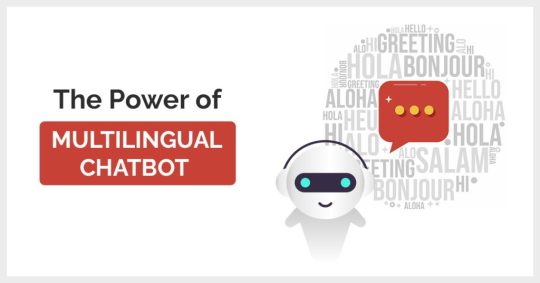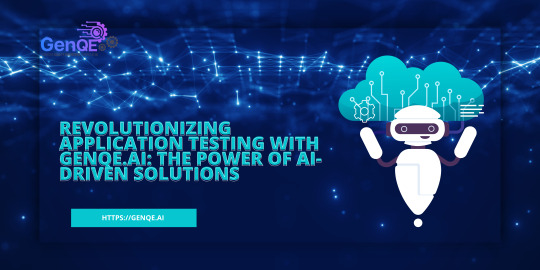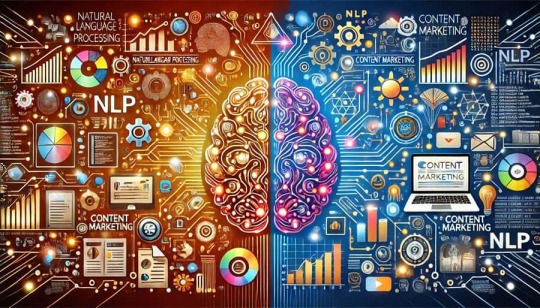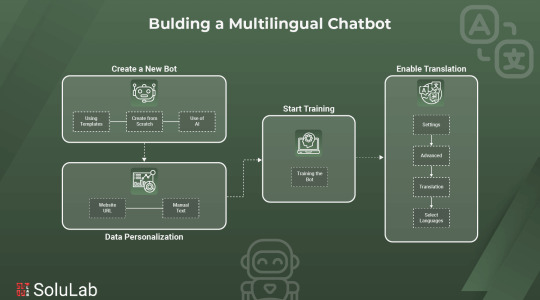#Multilingual Chatbots
Explore tagged Tumblr posts
Text
Best Multilingual Chatbots in HR | HONO

Experience unparalleled HR efficiency with HONO's best multilingual chatbots. Designed to transcend language barriers, our cutting-edge technology fosters seamless communication within diverse teams. Whether managing recruitment processes, facilitating employee onboarding, or streamlining HR inquiries, our chatbots ensure clarity and accessibility across languages. With advanced language processing capabilities and intuitive interfaces, HONO empowers organizations to optimize workforce engagement and productivity on a global scale. Trust HONO to revolutionize your HR operations, delivering unparalleled support and efficiency in navigating linguistic diversity. Welcome to a future where communication knows no bounds.
0 notes
Text
Don’t miss out on this opportunity to elevate your business. Sign up now with your email, and be among the first to experience the innovative features of ASKai.at. Let’s move beyond search and start sharing what makes your business truly special.
0 notes
Text
0 notes
Video
youtube
Navega las Leyes Sudamericanas con los Chatbots Legales IA de LexiAI
#Legal AI Chatbots#South American Law#Law#AI Legal Assistance#AI Legal Advisor#Legal Technology#Legal Tech Solutions#AI and Law#Multilingual Legal Chatbots#Law Chatbot#Legal Chatbots#Brazil Legal System#Brazilian Law#Brazilian Legal Framework#Argentina Law#Argentinian Law#Argentinian Legal Framework#Chile Legal Framework#Chilean Law#Chilean Legal Framework#Colombia Law Help#Colombian Law#Colombian Legal Framework#Peru Legal Aid#Peruvian Law#Peruvian Legal Framework#Ecuador Legal Chatbot#Ecuadorian Law#Ecuadorian Legal Framework#Venezuela Law Chatbot
0 notes
Text
"Into Eternal Memories: DeepBrain AI's Innovative Memorial Service, Re;memory - The From AI to Video, 2D/3D Virtual Reality, and Motion Capture, DeepBrain AI Expands the Horizon
The news of DeepBrain AI winning an Innovation Award at CES 2023 highlights the warmth and emotion that technology can bring to human life. This award was particularly made possible thanks to the ‘Re;memory’ service, which offers an innovative way to commemorate loved ones who have passed away by reproducing their appearance, mannerisms, and voice through AI. We all experience the cycle of life…

View On WordPress
#2d ai#3d ai#ai business#AI Chatbots for Business#AI Content Creation#ai motioncapture#ai studo#family#motioncature#Multilingual AI Translation#Video AI
0 notes
Text

Explore the world of multilingual chatbots and discover how they can help businesses expand their reach & boost user engagement in diverse markets.
0 notes
Text
The United States Army is employing a prototype generative artificial intelligence tool to identify references to diversity, equity, inclusion, and accessibility (DEIA) for removal from training materials in line with a recent executive order from President Donald Trump.
Officials at the Army’s Training and Doctrine Command (TRADOC)—the major command responsible for training soldiers, developing leaders, and shaping the service’s guidelines, strategies, and concepts—are currently using the AI tool, dubbed CamoGPT, to “review policies, programs, publications, and initiatives for DEIA and report findings,” according to an internal memo reviewed by WIRED.
The memo followed Trump’s signing of a January 27 executive order titled “Restoring America’s Fighting Force,” which directed Defense Secretary Pete Hegseth to eliminate all Pentagon policies seen as promoting what that the commander in chief declared “un-American, divisive, discriminatory, radical, extremist, and irrational theories” regarding race and gender, a linguistic dragnet that extends as far as past social media posts from official US military accounts.
In an email to WIRED, TRADOC spokesman Army Major Chris Robinson confirmed the use of CamoGPT to review DEIA materials.
TRADOC “will fully execute and implement all directives outlined in the Executive Orders issued by the president. We ensure that these directives are carried out with the utmost professionalism, efficiency, and in alignment with national security objectives,” Robinson says. “Specific details about internal policies and tactics cannot be discussed. However, the use of all tools in our portfolio, including CamoGPT, to increase productivity at all levels can and will be used.”
Developed last summer to boost productivity and operational readiness across the US Army, CamoGPT currently has around 4,000 users who “interact” with it on a daily basis, Captain Aidan Doyle, a CamoGPT data engineer, tells WIRED. The tool is used for everything from developing comprehensive training program materials to producing multilingual translations, with TRADOC providing a “proof of concept and demonstration” at last October’s annual Association of the United States Army conference in Washington, DC, according to Robinson.
While Doyle declined to comment on the specifics on how TRADOC officials were likely using the CamoGPT to scan for DEIA-related policies, he described the process of searching through documents as relatively straightforward.
“I would take all the documentation you want to examine, order it all in a collection on CamoGPT, and then ask questions about the documents,” he says. “The way retrieval-augmented generation works is that the more specific your question is to the concepts inside the document, the more detailed information the model will provide back.”
In practical terms, this means that TRADOC officials are likely inputting a large number of documents into CamoGPT and asking the LLM to scan for targeted keywords like “dignity” or “respect” (which, yes, the Army is currently using to screen past digital content) to identify materials for subsequent alteration and bring them in line with Trump’s executive order.
By using CamoGPT, the work of eliminating DEIA-related content will likely result in a rapid change to the US Army’s documentation. “We’re competing with ‘control+F’ in Adobe Acrobat,” Doyle says.
CamoGPT isn’t the only AI chatbot in the Pentagon’s arsenal: The US Air Force’s NIPRGPT has seen extensive use among airmen since its launch in June for “summarization of documents, drafting of documents and coding assistance,” according to DefenseScoop.
The AI-assisted assessment of US military training materials comes amid a government-wide effort to root out DEIA initiated the day Trump returned to the Oval Office in January to start his second term. Detailed in Trump’s January 27 executive order, the Defense Department’s purge has taken the form of the closure of service-specific DEIA offices and program, a department-wide review of past DEI initiatives, and even the removal of historical content related to the famed all-Black Tuskegee Airmen from Air Force basic training materials, the latter of which was swiftly reversed amid public outcry.
Originally inspired by the public release of OpenAI’s ChatGPT in November 2022, CamoGPT is a product of the Army’s Artificial Intelligence Integration Center (AI2C), the organization formed in 2018 as part of Army Future Command to spearhead AI research and development efforts by “leveraging a soldier workforce to build experimental prototypes,” as Eric Schmitz, AI2C’s operations and intelligence portfolio lead, tells WIRED.
“The mission is to make AI accessible to the Army through experimentation, and we have an ethos and culture that is very much a start-up ethos.” Schmitz says. “We are product-centric and believe AI is inherently software-driven: You can do all the research you like in academia, but if you don't have software to deliver it to somebody and find out if it's useful software, then you’ll never know if your AI is useful in the real world.”
In response to the arrival of ChatGPT, AI2C quickly spun up a CamoGPT prototype based on an open-source LLM in June 2024. The center’s approach to CamoGPT is “model agnostic,” according to Schmitz: While the system currently relies on tech giant Meta’s open-source Llama 3.3 70B LLM, the underlying model is “expendable” should a better version hit the market. What really matters is building software that the average soldier will actually use in their day-to-day operations, an achievement that might influence its long-term adoption across the force.
“When you talk about how the Army doesn’t build software well, it’s because user adoption is not a priority, but it’s a massive priority to us,” Schmitz says.
Whether CamoGPT proliferates more broadly across the Army remains to be seen, and Schmitz and Doyle emphasized that AI2C’s role is laser-focused on experimental prototyping rather than building products ready for immediate fielding. But with the entire federal government reorienting itself in the name of “efficiency,” the success of CamoGPT’s application to Trump’s DEIA overhaul may end up cementing its utility for military planners.
“You need to be ruthlessly critical of what you have built and what you plan to build and hyper focused on driving user adoption,” Schmitz says. “The core question is, how do you build something that’s so valuable that people say they can't live without it?”
4 notes
·
View notes
Text
Revolutionizing Enterprises: CXO’s GenAI Transformation

1. Unlocking AI’s Potential: A Strategic Overview
AI adoption, embraced by 70% of executives, promises enhanced customer experiences despite challenges. Understanding and integrating AI into business operations is essential. Explore our guide for actionable insights, ensuring businesses not only survive but thrive in the AI-driven era.
Learn more about Artificial Intelligence impact in 2025
AI Reshaping Decision-Making in 2025
Generative AI, like GPT, simplifies business processes. It transforms decision-making with its user-friendly interfaces, self-learning capabilities, and efficient sorting.
Furthermore, it’s a budget-friendly solution with no training fees, making it accessible for businesses of various sizes.
Our guide aims to offer practical insights for responsibly adopting this transformative technology. Following our roadmap allows businesses to navigate the Generative AI landscape, ensuring success in the constantly changing digital environment.
To stay informed and up to date with the latest trends, join our webinars featuring industry experts from organizations like Microsoft, Shell, and more.
C-Suite Roles Transformed by AI

Strategic AI Adoption Tips for Leaders
To successfully adopt AI, prioritize it for strategic goals, use tailored features, and embrace multilingual capabilities. Ensure secure deployment for data integrity. Offices that adopt AI enjoy streamlined processes, ongoing innovation, and secure frameworks.
2. Transforming C-Suite Roles with AI
Empowering CIOs: Innovating IT with AI
In enterprise IT, AI, particularly models like GPT, empowers CIOs to break traditional boundaries and improve operations through groundbreaking innovations.
Use Cases:
· Smart IT Helpdesk Support: AI ensures 24x7 support with human-like conversations, reducing user effort and cost.
· Smart Search: AI transforms data management, improving user engagement with easy-to-use search capabilities.
· Next-Gen Customer Support: AI automates email-based queries, crafting personalized responses for enhanced customer experiences.
To stay informed and up to date with the latest trends, join our webinars featuring industry experts from organizations like Microsoft, Shell, and more.
Implementation Tips:
· Prioritize AI for strategic goals.
· Personalized and multilingual capabilities.
· Ensure secure deployment for data integrity.
· Offices embracing AI experience streamlined helpdesks, continuous innovation, and secure frameworks.
Empowering HR with AI: From Administration to Leadership

Use Cases:
· AI-powered Talent Acquisition: AI streamlines global recruitment, automating candidate screening and optimizing interview scheduling.
· Efficient Employee Onboarding: AI redefines onboarding by using chatbots to create personalized experiences and promote communication across departments.
· Personalized Employee Engagement: AI’s learning capabilities drive adaptive engagement activities, ensuring timely interventions and integrating feedback loops.
· Data-Driven Learning and Development: AI changes learning through advanced knowledge mining, personalized modules, and interactive interfaces.
Implementation Tips:
· Align AI integration with strategic HR goals.
· Leverage AI’s personalization and multilingual features.
· Uphold data integrity and fortify security during deployment.
· Offices leveraging AI experience streamlined recruitment, efficient onboarding, personalized engagement, and reimagined L&D.
Also, read more about How GPT-powered Chatbots Can Help HR Leaders Drive Engagement and Retention
AI-Powered Marketing: A CMO’s Secret Weapon

Use Cases:
· AI-Powered Brand Engagement Solutions: AI revolutionizes brand engagement with personalized content, human-like communication, and timely identification of upsell opportunities.
· Smartly allocate ad spending: AI enables CMOs to allocate budgets wisely by analyzing real-time market trends predictively.
Implementation Tips:
· Prioritize AI Integration aligned with core marketing goals.
· Leverage Multilingual Features for global brand reach.
· Strategize Deployment with a focus on data integrity and customer privacy.
· Offices with AI experience tailored brand engagement, proactive ad spend decisions, and seamless multilingual marketing.
Explore the Power of Generative AI for enhancing CX — Marketing and Customer support/ Engagement
AI: The COO’s Catalyst for Operational Agility and Efficiency
In the realm of Operational efficiency, Chief Operating Officers (COOs) orchestrate processes to optimize resources.
Use Cases:
· Simplifying the supply chain: Artificial Intelligence (AI) provides a high-level perspective, facilitating proactive demand forecasting and prompt corrective actions for effective supply chains.
· Enhancing Operational Communication: AI-powered chatbots ensure role-specific information flow, facilitating real-time feedback and swift issue resolution.
· Driving Operational Cost Optimization: AI analyzes data for cost leakage points, recommends resource redistribution, and encourages real-time cost insights.
To stay informed and up to date with the latest trends, join our webinars featuring industry experts from organizations like Microsoft, Shell, and more.
Implementation Tips:
· Justify Integration Effort with improved operational KPIs.
· Leverage Iterative Learning for continuous process refinement.
· Prioritize Data Security, safeguarding organizational assets.
· Offices with AI experience data-driven supply insights, intelligent communication, and dynamic cost optimization.
· In the dynamic field of data management, Chief Data Officers (CDOs) use AI, including GPT and other generative AI models, as strong supporters to decode large datasets effectively.
Use Cases:
· Enhancing Data Intelligence: AI’s advanced algorithms mine data, providing insights that shape business strategies through predictive modeling and intelligent summarizing.
· Managing Unstructured Data: AI’s NLP features efficiently process and convert unstructured data into organized, clear formats, enhancing data processing efficiency.
· Enhancing Data Governance: AI simplifies data management by automating organization, ensuring compliance with regulatory policies, real-time breach detection, and maintaining data standards.
Implementation Tips:
· Start with a clear data strategy aligning AI’s abilities with major data challenges.
· Prioritize data protection in AI adoption for utility and security.
· Invest in continuous training, refining AI models for better understanding of organizational data.
· Offices with AI experience automated, intelligent data insights, streamlined data, and proactive, AI-assisted data governance.
3. AI’s Impact: Boosting Enterprise Efficiency
Discover how advanced AI, including Azure OpenAI’s GPT, is reshaping enterprise operations. Explore real-world use cases across departments, showcasing the profound impact of Generative AI on organizational efficiency.
AI Integration Across Departments
SharePoint Search Integration

Structured Data Insights & Summarization
AI enables the effortless transformation of structured data into actionable intelligence. This module analyzes tables and databases, extracting meaningful insights presented in user-friendly natural language summaries, empowering teams for informed decision-making.
R&D Assistant
In Research and Development, AI acts as a dedicated assistant, leveraging internal and external data sources for comprehensive reports and analysis.
Customer/Consumer Support
Elevate customer support with an AI-powered chatbot that delivers personalized and context-aware responses. By training the model with customer support data, this solution ensures accuracy and seamless integration with existing systems.
HR Chatbot
AI becomes an invaluable virtual assistant in HR, guiding employees through common queries with personalized responses. From leave requests to company policies, this intelligent chatbot ensures a seamless and efficient employee experience.
IT Chatbot
Revolutionize IT support by using an AI-powered chatbot. The chatbot can troubleshoot common issues, give step-by-step instructions, and escalate complex cases. Enhance user experience and streamline technical support with this essential tool.
To stay informed and up to date with the latest trends, join our webinars featuring industry experts from organizations like Microsoft, Shell, and more.
Document Comparison/RFP Validation
AI streamlines procurement and HR processes by comparing documents. Quickly analyze text documents for similarities, differences, and changes, ensuring accuracy in document validation and specifications.
Procurement Assistant
Automate and streamline the procurement process with an AI-powered assistant. Generate purchase orders, request for quotations, and vendor evaluations based on predefined templates and user inputs, ensuring efficiency and accuracy.
Search Integration with SAP JAM/ServiceNow KB/Salesforce KB
Bridge the knowledge gap by integrating AI with ERP and ITSM systems. Enable interactive conversations beyond search results, enhancing user understanding and engagement with content.
Knowledge Management Solution
Empower your workforce with a Knowledge Management Solution seamlessly merging AI with Azure Cognitive Search. Unlock information from diverse sources, fostering a culture of knowledge-sharing and collaboration.
Integrate innovative AI use cases into your strategy for streamlined processes and enhanced user experiences.
4. Unlocking AI’s Power with Acuvate: A Comprehensive Guide
As businesses embrace AI’s transformative potential, Generative Pre-trained Transformers (GPT) take center stage, enhancing productivity. Our guide delves into AI FAQs, ensuring data security and adaptability for enterprise needs.
To stay informed and up to date with the latest trends, join our webinars featuring industry experts from organizations like Microsoft, Shell, and more.
Acuvate Advantage
Experience the Org Brain GPT framework, combining analytics and enterprise security. Acuvate’s expertise, spanning 16 years, ensures customized AI solutions for streamlined processes.
Explore our AI trends guide to boost your organization’s capabilities. Request a demo or insight into Acuvate’s transformative AI solutions for enhanced performance.
Also, read our other blogs on the AI revolution on Medium
9 Must-Watch Webinars of 2025 for Tech Enthusiasts | Medium
- AI-Driven Transformation: A CXO's Guide to Generative AI Success | Medium
GPT Revolution in AI - A Strategic Guide for CXO | Medium
Emerging Energy Technologies: Data, AI & Digital Solutions in 2025 | Medium
#hyperautomation#microsoft fabric#tech webinars 2025#ai#artificial intelligence#data integration#data platforms#machine learning
2 notes
·
View notes
Text
AI Chatbot Development Services for Seamless Customer Support
Our AI-based chatbot development services are designed to provide businesses with an efficient
and scalable solution to improve customer service and streamline workflows. With advanced features such as 24/7 availability, multilingual support, and seamless integration with CRM, ERP, and other business systems, our chatbot platform ensures a smooth customer experience.
We offer highly customizable chatbots tailored to your brand’s voice, enabling businesses to manage high volumes of interactions, enhance user engagement, and boost sales. Our chatbots also feature in-depth analytics that provides valuable insights into user behavior, helping you continuously optimize your customer service efforts. Whether you’re a small and medium enterprise (SME) or a large business enterprise, our chatbot services can be adapted to meet your specific needs. With support for both audio and video calls, and integration with multiple platforms like AWS, Google Cloud, and Azure, our chatbots are the smart choice for businesses looking to improve customer satisfaction and drive revenue growth.
Contact Information
Email: [email protected]
Phone Numbers: +1 408 454 6110
Location: 410 E Santa Clara Street, Unit #1023, San Jose, CA 95113
#<Ai Chatbot solutions>#<Ai chatbot development>#<chatbot services>#<Ai chatbot app development>#<Customer service Automation>#<Chatbot integration>
2 notes
·
View notes
Text
Revolutionizing Application Testing with GenQE.ai: The Power of AI-Driven Solutions

In the ever-evolving tech landscape, efficient testing of applications has become more critical than ever. GenQE.ai, a cutting-edge AI-driven platform, is redefining the way testing is conducted by automating and streamlining the process. Designed to integrate seamlessly with CI/CD pipelines, GenQE ensures comprehensive test coverage, minimizes manual efforts, and enhances testing accuracy—all while keeping pace with the rapid development cycles of modern applications.
At the heart of GenQE’s innovation is its focus on intelligent test case generation and automation of test execution, making it a go-to solution for teams aiming to improve efficiency and quality.
"AI Tests AI" Add-On: A Game-Changer for AI System Testing
One of GenQE’s standout features is its "AI Tests AI" add-on, a scalable solution specifically designed to rigorously test AI systems. This feature generates multiple variations of a single prompt to mimic real-world scenarios, ensuring that AI systems are prepared to handle diverse user inputs accurately.
Key Features of the "AI Tests AI" Add-On
Automated Testing of Real-World Scenarios:
Typo Simulation: Mistakes happen, but your AI should be smart enough to understand them. GenQE evaluates your AI’s ability to interpret prompts containing common typos, ensuring user-friendly interactions.
Slang and Regional Variations: Language is dynamic, with regional slang and dialects adding complexity. GenQE tests AI systems with varied phrasing to ensure inclusivity and adaptability.
Multilingual Input: In today’s globalized world, linguistic diversity is essential. GenQE assesses your AI’s performance in multiple languages, guaranteeing readiness for a global audience.
Handling Incomplete Sentences: Users don’t always articulate complete thoughts. GenQE simulates incomplete queries to evaluate the AI’s contextual understanding and robustness.
Seamless Integration with Industry Tools
Efficiency extends beyond testing. The "AI Tests AI" add-on integrates effortlessly with popular project management and development tools like JIRA and GitLab, enabling teams to:
Log test results in real-time.
Track and prioritize issues.
Collaborate effectively across teams.
This seamless integration streamlines workflows, ensuring that teams can address issues promptly and stay aligned with development goals.
Real-Time Insights for Continuous Improvement
One of GenQE’s most valuable offerings is its real-time performance scoring. Every AI response is scored based on performance metrics, providing actionable insights into strengths and areas for improvement. This data-driven feedback loop empowers teams to fine-tune their AI systems continuously, ensuring they remain reliable and effective over time.
The Future of Application Testing
GenQE.ai is setting a new standard for testing by combining intelligent automation with actionable insights. Its ability to handle real-world scenarios, support multilingual inputs, and provide seamless integration with existing tools makes it an indispensable solution for teams striving to optimize their AI and application testing processes.
Whether you’re developing a chatbot, an automated assistant, or a global AI platform, GenQE ensures that your systems are robust, reliable, and ready for any challenge.
1 note
·
View note
Text
Predicting Upcoming Trends in NLP and Content Marketing: What Businesses Need to Know
In the fast-evolving landscape of digital marketing, Natural Language Processing (NLP) is emerging as a game-changer. NLP, a branch of artificial intelligence, enables machines to understand, interpret, and respond to human language in a valuable way. With its integration into content marketing, the future of NLP in content marketing looks incredibly promising. Let’s dive into the upcoming NLP trends and their potential impacts on businesses and marketers. Plus, I’ll share strategies to help you stay ahead of these advancements.
Understanding NLP and Its Importance for content marketing
What is NLP?
Natural Language Processing (NLP) is the intersection of linguistics, computer science, and artificial intelligence. It focuses on enabling machines to comprehend and process human language. Think of it as the technology behind your favourite voice assistant or the predictive text in your smartphone.
Why NLP Matters in Content Marketing
Content marketing is all about delivering the right message to the right audience. With NLP, marketers can better understand user intent, personalise content, and enhance user engagement. By leveraging NLP, businesses can craft content that resonates more profoundly with their audience.
Upcoming NLP Trends in Content Marketing
1. Enhanced Sentiment Analysis
Sentiment analysis is no longer about simply identifying positive or negative sentiments. The future of NLP in content marketing will involve more nuanced sentiment analysis, understanding complex emotions like sarcasm, irony, and mixed feelings. This will help brands gauge customer sentiment more accurately and tailor their strategies accordingly.
2. Advanced Personalisation for content marketing
Personalisation will reach new heights with NLP. Imagine a world where content is not just personalised by demographic data but also by real-time behavioural data. NLP will enable marketers to create hyper-personalised content marketing, enhancing user experience and driving higher engagement rates.
3. Improved Chatbots and Virtual Assistants
Chatbots and virtual assistants will become even more sophisticated. They’ll understand context better, offer more relevant responses, and engage users in more natural conversations. This advancement will revolutionise customer service and engagement in content marketing.
4. Content marketing and generation
NLP-powered content generation tools will become mainstream. These tools will assist marketers in creating high-quality content marketing quickly and efficiently, from blog posts to social media updates. They’ll understand the tone, style, and context needed, ensuring consistency in brand messaging.
5. Voice Search Optimisation
As voice search continues to rise, NLP will play a crucial role in optimising content for voice queries. Marketers will need to focus on creating conversational content marketing that aligns with how people speak rather than type.
6. Multilingual Capabilities
Breaking language barriers will be easier than ever. NLP will facilitate the creation of multilingual content, allowing brands to reach a global audience effortlessly. This trend will be pivotal for businesses aiming to expand their international presence.
Potential Impacts on Businesses and Marketers
Transforming Customer Interactions
NLP will transform how businesses interact with their customers. With advanced chatbots and virtual assistants, companies can provide instant support and personalised recommendations, enhancing customer satisfaction and loyalty.
Data-Driven Insights
NLP will offer deeper insights into customer behaviour and preferences. By analysing large volumes of data, businesses can make more informed decisions and refine their marketing strategies to meet customer needs better.
Boosting SEO Efforts for content marketing
NLP will significantly impact SEO strategies. Search engines are becoming smarter at understanding user intent, and NLP will help marketers optimise their content to align with these evolving algorithms. This means higher search rankings and increased organic traffic.
Enhancing Content Marketing Quality
With NLP, content quality will improve dramatically. Automated content generation tools will assist in creating well-structured, engaging, and error-free content. This will save time and resources while maintaining a high standard of content output.
Strategies to Stay Ahead in NLP Advancements
1. Invest in NLP Technology
Investing in the right NLP tools and technologies is crucial. Whether it’s for sentiment analysis, content generation, or chatbots, having the right tools will give you a competitive edge.
2. Focus on Data
Data is the backbone of NLP. Ensure you have a robust data collection and analysis strategy in place. This will help you understand your audience better and create more targeted and effective content.
3. Keep Up with Trends
The world of NLP is continuously evolving. Stay updated with the latest upcoming NLP trends and advancements by following industry blogs, attending conferences, and participating in webinars.
4. Leverage Expert Help
Consider working with experts in NLP and content marketing. Agencies like AI SEO Services offer comprehensive services that can help you navigate the complexities of NLP and maximise its benefits for your business.
5. Train Your Team
Ensure your marketing team is well-versed in NLP technologies and their applications. Provide training and resources to help them stay updated and proficient in using these tools effectively.
6. Optimise for Voice Search
With the rise of voice search, optimising your content for voice queries is essential. Focus on creating conversational content and using long-tail keywords that match natural speech patterns.
7. Prioritise User Experience in Content Marketing
At the end of the day, user experience is paramount. Use NLP to enhance the overall user experience on your website and other digital platforms. Personalised, relevant, and engaging content will keep users coming back.
8. Monitor and Adapt
Regularly monitor the performance of your NLP strategies and be ready to adapt as needed. The digital landscape is dynamic, and staying flexible will help you stay ahead of the future of NLP in content marketing.
Conclusion
NLP is set to revolutionise content marketing, offering unprecedented opportunities for businesses and marketers. By staying informed about upcoming trends and proactively adopting NLP technologies, you can ensure your marketing strategies remain effective and competitive. Remember, the key to success lies in understanding your audience, delivering personalised content, and continuously adapting to the ever-changing digital landscape.
Speaking of staying ahead, AI SEO Services is a leading agency that can help you leverage NLP and other cutting-edge technologies for your content marketing needs. Our services include everything from web design to copywriting, SEO, and voice search optimisation. Check out our testimonials to see how we’ve helped other businesses succeed.Incorporating the upcoming NLP trends and staying ahead in the content marketing game is easier with the right partner. For comprehensive and expert guidance, consider AI SEO Services agency services around this keyword: AI SEO Services. Our team is dedicated to helping you harness the power of AI and NLP to drive your business forward. From AI-driven SEO to content marketing, we’ve got you covered.

3 notes
·
View notes
Video
youtube
Navigate South American Laws with LexiAI’s Legal AI Chatbots
#LexiAI#Legal AI Chatbots#South American Law#Law#AI Legal Assistance#AI Legal Advisor#Legal Technology#Legal Tech Solutions#AI and Law#Multilingual Legal Chatbots#Law Chatbot#Legal Chatbots#brazil legal system#brazilian law#Brazilian Legal Framework#Argentina Law#Argentinian Law#Argentinian Legal Framework#Chile Legal Framework#Chilean Law#Chilean Legal Framework#Colombia Law Help#Colombian Law#Colombian Legal Framework#Peru Legal Aid#peruvian law#Peruvian Legal Framework#Ecuador Legal Chatbot#Ecuadorian Law#Ecuadorian Legal Framework
0 notes
Text
"Top 5 Noteworthy AI Writing Tools to Choose From in 2024"
NOTION Notion has seen remarkable growth in Korea! It’s an indispensable AI tool. Performance: Notion provides a unified interface for documents, databases, and project management tools. Users can easily create and manage various types of content, including text, images, tables, and checklists, through Notion. Usage Examples: Project Management and Collaboration: Track the progress of team…

View On WordPress
#AI Blog Writing Software#AI Chatbots for Business#AI Content Creation#AI Writing Assistance#AI-Powered Customer Service#Content Strategy Automation#Digital Marketing AI#Multilingual AI Translation#Personalized Content AI#SEO Optimization Tools
0 notes

